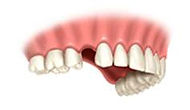Dental Implants
Improved quality of life
Implant-supported replacement teeth look, feel and function like natural teeth. They are the gold-standard for tooth replacement therapy and we see them improving patients quality of life every day.

Single Tooth Replacement
When a single tooth needs to be removed, the best permanent replacement is most often a dental implant in conjunction with a ceramic crown. This solution both looks and functions most like a natural tooth
Installing the New Tooth Step by Step
The following simplification is for illustrative purposes.
1: Before the procedure
The dentist makes a first examination and takes one or more x-rays of the area to prepare for the procedure.
2: Installing the implant
The implant is installed. At this time, a temporary tooth often is provided. The implant will need a several months to integrate with the jawbone before the next step is taken.
3: Attaching the new crown
The final step is the placement of the permanent ceramic tooth. No additional treatment is needed and often the new tooth will last for the rest of your life.
4: End result
You should expect the new tooth to fit and function just like a natural tooth, it will have to be cleaned and maintained just like every other natural tooth in the mouth.
Alternative to a single implant
A traditional bridge involves reshaping adjacent teeth to support the bridge. It is a stable solution with good esthetics and function that is fairly easy to install.
This is not typically a permanent alternative to a lost tooth. Made of plastic, it is typically unstable and loosely attached. That said there are a few benefits. A removal partial denture is easily and quickly installed, relatively cheap, and a good temporary tooth replacement in a pinch.






Multiple Teeth Replacement
Often, when replacing several teeth in the far back of the mouth, a fixed bridge anchored to dental implants is the only fixed alternative. Traditional dentures can't offer the same stability or function.
Having dental implants replacing your lost back teeth will give you new, unparalleled strength and stability that allows you to eat what you want. It will also preserve your jawbone and facial appearance.
Installing the Fixed Bridge Step by Step
The following simplification is for illustrative purposes.
1: Before the procedure
In this example three teeth at back end of the mouth are missing. The only real fixed replacement alternative is installing a implant supported bridge. The bridge contains all teeth in one piece and is anchored on dental implants.
2: Installing the implant
First, the implants are installed. This is normally done in a single session. A temporary bridge can sometimes be placed at the same time, making it possible for you to function like normal almost immediately after leaving the dentist.
3: Attaching the bridge
The implants need to integrate with the jawbone before the permanent bridge is attached. This is normally done several months after the implant installation. The time will vary, depending on the teeth affected and the esthetical demands.
4: End result
The new bridge will handle all the pressure that your strong, natural back teeth did. You will have a stable and secure solution that allows you to eat what you want.
Alternatives to a fixed bridge
This alternative is often perceived as uncomfortable and a bit complicated to use. Function can’t be compared to that of a bridge. This denture is made of plastic and metal, which affects its look. However, the benefits are its relatively cheap cost and the installation process is simpler and quicker.





Full Arch Replacement
When all teeth are missing or they need to be removed, a fixed bridge anchored to dental implants is normally the best permanent solution.
Before dental implants, there were no fixed solution available for people who lost all their teeth. Today, it is possible to replace a full jaw with dental implants and a fixed bridge that results in a permanent, stable and high esthetic solution.
-
Lets you eat and function like having natural teeth
-
A solid, stable solution that will serve you for life
-
Preserves your facial appearance and prevents bone loss
Installing the Fixed Bridge Step by Step
The following simplification is for illustrative purposes.
1: Before the procedure
The dentist determines what needs to be done and prepares both himself and the patient for the coming treatment procedure.
2: Installing the implants
The first step is installing dental implants to replace the lost tooth roots. In this case, five implants are used. Temporary teeth are attached that enable you to eat and function like normal while waiting for the permanent bridge to be installed.
3: Attaching the bridge
The final bridge is securely installed on top of the implants. With a full jaw replacement like this, it normally takes a few visits to have the bridge completely attached.
4: End result
Your new teeth should be hard to tell from natural – both for you and others. People who have had traditional dentures before getting a fixed bridge often describe this as an overwhelming and very positive experience.
Alternatives to a fixed full mouth bridge
Removable, implant anchored overdenture
An alternative to a fixed bridge is a removable over-denture, which is anchored on implants.
The implants help keep the denture in place and provide better function and comfort. Cost is usually the reason why this solution is chosen over a fixed bridge, but it does have benefits over a conventional complete denture, particularly for lower teeth.
Removable full denture
A denture that is loosely placed on top of the gum to cover the lost teeth. This alternative has the advantages of its lower relative price and easy installation.
The disadvantages are many: discomfort in eating, less ideal esthetics, affected speech, and the possibility of sore gums from denture movement. Moreover, a full denture placed in the upper jaw reduces the sense of taste.





